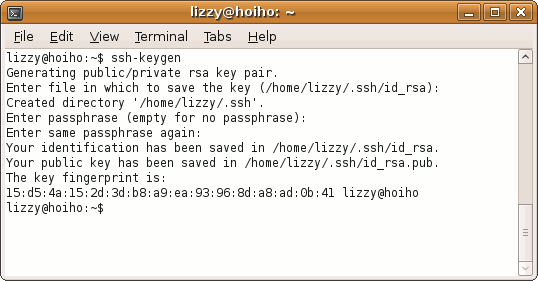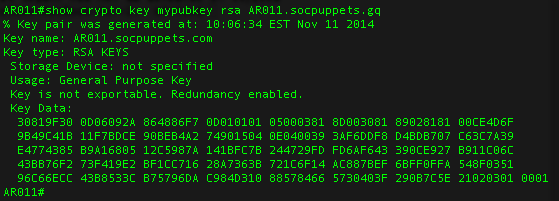Command To Generate An Rsa Key Pair
With a given key pair, data that is encrypted with one key can only be decrypted by the other. This is useful for encrypting data between a large number of parties; only one key pair per person need exist. RSA is widely used across the internet with HTTPS. To generate a key pair, select the bit length of your key pair and click Generate key.
- Openssl Command To Generate Rsa Key Pair
- Openssl Generate Rsa Key Pair
- Command To Generate Rsa Key Pair
Instances use an SSH key pair instead of a password to authenticate a remote user. A key pair file contains a private key and public key. You keep the private key on your computer and provide the public key every time you launch an instance.
To create key pairs, you can use a third-party tool such as OpenSSH on UNIX-style systems (including Linux, Solaris, BSD, and OS X) or PuTTY Key Generator on Windows.
You can generate an SSH key pair directly in cPanel, or you can generate the keys yourself and just upload the public one in cPanel to use with your hosting account. When generating SSH keys yourself under Linux, you can use the ssh-keygen command. Create a DSA or RSA key pair that has no passphrase associated with it. Use the commands below to create either a DSA or RSA key pair. Ssh-keygen -t dsa -N ' ssh-keygen -t rsa -N ' Note: During key generation, SSH will check to see if there is a.ssh folder underneath the user's home directory. If one does not exist, the folder will be. May 27, 2010 Linux Generate RSA SSH Keys last updated May 27, 2010 in Categories Linux. H ow do I generate ssh RSA keys under Linux operating systems? You need to use the ssh-keygen command as follows to generate RSA keys (open terminal and type the following command): ssh-keygen -t rsa OR.
That generates a 2048-bit RSA key pair, encrypts them with a password you provide and writes them to a file. You need to next extract the public key file. You will use this, for instance, on your web server to encrypt content so that it can only be read with the private key. Export the RSA Public Key to a File. This is a command that is. SiteGround uses key pairs for SSH authentication purposes, as opposed to plain username and password. More information on SSH keys is available here. You can generate an SSH key pair in Mac OS following these steps. You can generate an SSH key pair directly in cPanel, or you can generate the keys yourself and just upload the public one in cPanel to use with your hosting account. When generating SSH keys yourself under Linux, you can use the ssh-keygen command.
Before You Begin
- If you already have an SSH-2 RSA key pair, you can use your existing pair and skip this step. Proceed to Choosing a Compartment.
- If you're using a Linux distribution, you probably already have the
ssh-keygenutility installed. To determine if it's installed, typessh-keygenon the command line. If it's not installed, you can download OpenSSH for UNIX from http://www.openssh.com/portable.html and install it. - If you're using Windows and you don't already have the PuTTY Key Generator, download it from http://www.putty.org and install it.
Creating a Key Pair
Creating an SSH Key Pair on the Command Line- Open a shell or terminal for entering the commands.
At the prompt, enter
ssh-keygenand provide a name and passphrase when prompted.The keys will be created with the default values: RSA keys of 2048 bits.
Alternatively, you can type a complete ssh-keygen command, for example:
The command arguments are shown in the following table:
| Argument | Description |
|---|---|
-t rsa | Use the RSA algorithm. |
-N '<passphrase>' | A passphrase to protect the use of the key (like a password). If you don't want to set a passphrase, don't enter anything between the quotes. A passphrase is not required. You can specify one as a security measure to protect the private key from unauthorized use. |
-b 2048 | Generate a 2048-bit key. You don't have to set this if 2048 is acceptable, as 2048 is the default. A minimum of 2048 bits is recommended for SSH-2 RSA. |
-C '<key_name>' | A name to identify the key. |
-f <path/root_name> | The location where the key pair will be saved and the root name for the files. |
- Find
puttygen.exein the PuTTY folder on your computer, for example,C:Program Files (x86)PuTTY. Double-clickputtygen.exeto open it. Specify a key type of SSH-2 RSA and a key size of 2048 bits:
- In the Key menu, confirm that the default value of SSH-2 RSA key is selected.
- For the Type of key to generate, accept the default key type of RSA.
- Set the Number of bits in a generated key to 2048 if it is not already set.
- Click Generate.
Move your mouse around the blank area in the PuTTY window to generate random data in the key.
When the key is generated, it appears under Public key for pasting into OpenSSH authorized_keys file. Photoshop cs6 extended serial key.
- A Key comment is generated for you, including the date and time stamp. You can keep the default comment or replace it with your own more descriptive comment.
- Leave the Key passphrase field blank.
Click Save private key, and then click Yes in the prompt about saving the key without a passphrase.
The key pair is saved in the PuTTY Private Key (PPK) format, which is a proprietary format that works only with the PuTTY tool set.
You can name the key anything you want, but use the
ppkfile extension. For example,mykey.ppk.Select all of the generated key that appears under Public key for pasting into OpenSSH authorized_keys file, copy it using Ctrl + C, paste it into a text file, and then save the file in the same location as the private key.
(Do not use Save public key because it does not save the key in the OpenSSH format.)
You can name the key anything you want, but for consistency, use the same name as the private key and a file extension of
pub. For example,mykey.pub.- Write down the names and location of your public and private key files. You will need the public key when launching an instance. You will need the private key to access the instance via SSH.
What's Next
Now that you have a key pair, continue on with Choosing a Compartment.
-->To sign an assembly with a strong name, you must have a public/private key pair. This public and private cryptographic key pair is used during compilation to create a strong-named assembly. You can create a key pair using the Strong Name tool (Sn.exe). Key pair files usually have an .snk extension.
Openssl Command To Generate Rsa Key Pair
Note
In Visual Studio, the C# and Visual Basic project property pages include a Signing tab that enables you to select existing key files or to generate new key files without using Sn.exe. In Visual C++, you can specify the location of an existing key file in the Advanced property page in the Linker section of the Configuration Properties section of the Property Pages window. The use of the AssemblyKeyFileAttribute attribute to identify key file pairs was made obsolete beginning with Visual Studio 2005.
Create a key pair
To create a key pair, at a command prompt, type the following command:
sn –k <file name>
In this command, file name is the name of the output file containing the key pair.
The following example creates a key pair called sgKey.snk.

If you intend to delay sign an assembly and you control the whole key pair (which is unlikely outside test scenarios), you can use the following commands to generate a key pair and then extract the public key from it into a separate file. First, create the key pair:
Next, extract the public key from the key pair and copy it to a separate file:
Once you create the key pair, you must put the file where the strong name signing tools can find it.
When signing an assembly with a strong name, the Assembly Linker (Al.exe) looks for the key file relative to the current directory and to the output directory. When using command-line compilers, you can simply copy the key to the current directory containing your code modules.
Openssl Generate Rsa Key Pair
If you are using an earlier version of Visual Studio that does not have a Signing tab in the project properties, the recommended key file location is the project directory with the file attribute specified as follows:
